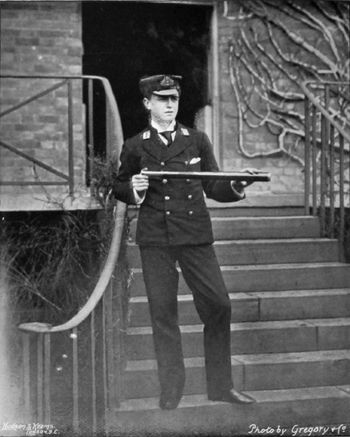Difference between revisions of "Gerard Aylmer Wells"
(add RN/RNR/RNVR categories) |
|||
| Line 47: | Line 47: | ||
{{CatVice|UK}} | {{CatVice|UK}} | ||
{{CatBritannia|January, 1893}} | {{CatBritannia|January, 1893}} | ||
| + | {{CatRN}} | ||
Latest revision as of 16:46, 7 April 2022
Vice-Admiral SIR Gerard Aylmer Wells, K.B.E., R.N. (6 October, 1879 – 2 August, 1943) was an officer in the Royal Navy.
Life & Career
Gerard Wells was born in Southsea, the son of Admiral SIR Richard Wells, and entered the Royal Navy on 15 January, 1893.[1]
Wells was promoted to the rank of Lieutenant on 30 June, 1901.
In July 1907, he passed a preliminary examination in French.
Wells was promoted to the rank of Commander on 30 June, 1913. At the end of July, he was admitted to Haslar Hospital, suffering from hemorrhoids. He was again fit on 11 September.
His service during the war appears to be somewhat of a mystery. From 4 August, 1913 he was placed on the books of President for "special service", and this extended into 1916. After some time at (perhaps) Malta and Portsmouth, he was sent to the battleship Centurion from 17 November 1916 to 16 July, 1918. He finished out the war on a Resource Committee, being promoted to the rank of Captain on 30 June, 1918.[2]
He was appointed command of the light cruiser Comus on 15 November, 1918.[3] On 20 March, 1919, he was appointed in command of the Comus's near-sister Cambrian.[4]
Wells was appointed Naval Attaché to the nations of South America[5] on 8 June, 1923, with his headquarters in Beunos Aires.[6]
On return from South America, Wells was appointed in command of the light cruiser Weymouth on 7 April, 1926. Weymouth was flagship of Vice-Admiral Sir Rudolf W. Bentinck, the Vice-Admiral Commanding, Reserve Fleet, and Wells served as Bentinck's Flag Captain and Chief of Staff.[7]
He was placed on the Retired List at his own request on 11 September, 1930.
He was promoted to Vice-Admiral on the Retired List on 16 January, 1935.[8]
See Also
| Naval Appointments | ||
| Preceded by John M. Casement |
Captain of H.M.S. Comus 15 Nov, 1918[9] – 20 Mar, 1919 |
Succeeded by Cathcart R. Wason |
| Preceded by Lockhart Leith |
Captain of H.M.S. Cambrian 20 Mar, 1919[10] – Feb, 1921 |
Succeeded by James D. D. Stewart |
| Preceded by Thomas N. James |
Captain of H.M.S. Centurion 31 Jul, 1925 – Apr, 1926 |
Succeeded by Robert S. MacFarlan |
| Preceded by Norman M. C. Thurstan |
Captain of H.M.S. Weymouth Apr, 1926 – 1 Apr, 1927 |
Succeeded by Astley D. C. Cooper-Key |
| Preceded by Astley D. C. Cooper-Key |
Captain of H.M.S. Dartmouth 1 Apr, 1927[11] – 15 Aug, 1927 |
Succeeded by Dudley B. N. North |
| Preceded by William M. James |
Captain of H.M.S. Royal Sovereign 19 Dec, 1927[12] – Aug, 1929 |
Succeeded by Basil G. Washington |
Footnotes
- ↑ The Navy & Army Illustrated 1 (5): p. 98.
- ↑ The Navy List. (December, 1918). p. 335a.
- ↑ The Navy List. (December, 1918). p. 763.
- ↑ The Navy List. (December, 1920). p. 739.
- ↑ Given in the Navy List as Brazil, Argentina, Uruguay, Paraguay, Venezuela, Chile, Colombia, Ecuador, and Peru.
- ↑ The Navy List. (December, 1924). p. 421.
- ↑ The Navy List. (June, 1926). p. 288.
- ↑ The Navy List. (August, 1939). p. 719.
- ↑ The Navy List. (December, 1918). p. 763.
- ↑ The Navy List. (December, 1920). p. 739.
- ↑ The Navy List. (July, 1927). p. 230.
- ↑ The Navy List. (February, 1929). p. 266.
